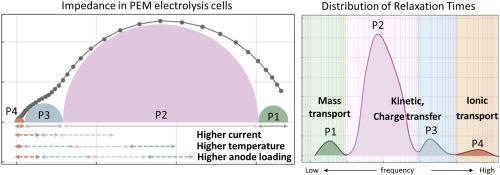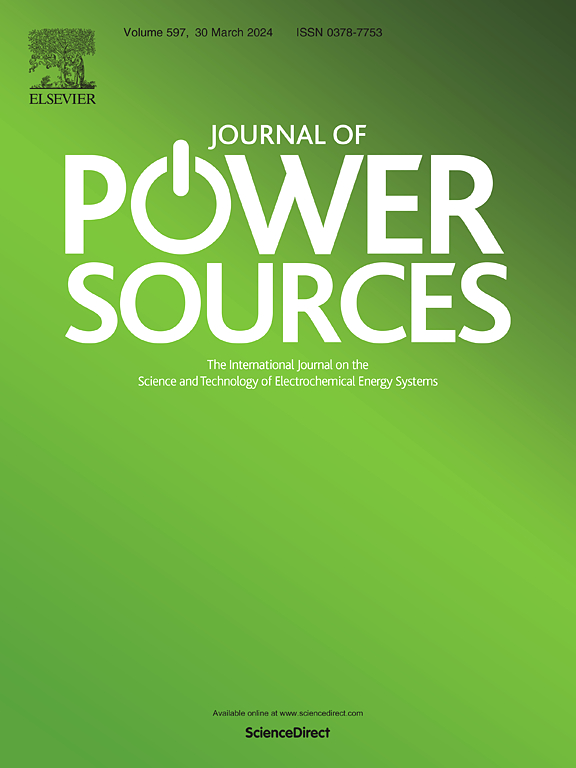通过质子交换膜电解槽中弛豫时间的分布识别电化学过程
IF 8.1
2区 工程技术
Q1 CHEMISTRY, PHYSICAL
引用次数: 0
摘要
弛豫时间分布(DRT)用于解释质子交换膜(PEM)水电解槽的电化学阻抗光谱(EIS),试图在奈奎斯特图中分离重叠的弛豫过程。通过改变操作条件和催化剂负载,可以确定 EIS 产生的四个主要弛豫峰,并成功地将其从低频到高频分离为 (P1) 质量传输、(P2) 氧进化反应动力学、(P3) 反应动力学(时间常数比 P2 快)和 (P4) 离子传输。DRT 峰的形状、高度和频率随不同的膜电极组件(MEA)配置而变化。电子显微镜显示了横截面 MEA 的明显特征,这些特征验证了 DRT 的关键结果,即铱 (Ir) 阳极负载从 0.2 mgIr/cm2 增加到 1.5 mgIr/cm2,会因更高的位点访问量而减少动力学损失;但是,厚而紧凑的阳极也会因膜/催化剂层水化而引发更高的欧姆电阻,并因更长的离子聚合物路径而增加传输损失。DRT 比 EIS 具有更高的分辨率,可用于分解具有不同弛豫时间的过程,而且 DRT 峰值的量化可改进对每个过程总损失的计算。本文章由计算机程序翻译,如有差异,请以英文原文为准。

Identifying electrochemical processes by distribution of relaxation times in proton exchange membrane electrolyzers
Distribution of relaxation time (DRT) is used to interpret electrochemical impedance spectroscopy (EIS) for proton exchange membrane (PEM) water electrolyzers, with an attempt to separate overlapped relaxation processes in Nyquist plots. By varying operating conditions and catalyst loadings, four main relaxation peaks arising from EIS can be identified and successfully separated from low to high frequencies as (P1) mass transport, (P2) oxygen evolution reaction kinetics, (P3) reaction kinetics (with faster time constant than P2), and (P4) ionic transport. The shape, height, and frequency of the DRT peaks change with different membrane electrode assembly (MEA) configurations. Electron microscopy reveals distinct features from the cross-sectioned MEAs which verify critical DRT results in that increasing the iridium (Ir)-anode loading from 0.2 mgIr/cm2 to 1.5 mgIr/cm2 reduces kinetic losses due to higher site-access; a thick and compacted anode, however, also triggers higher ohmic resistances from membrane/catalyst layer hydration and increases transport losses due to longer ionomer pathways. DRT provides higher resolution to EIS for deconvoluting processes with different relaxation times and the quantification of DRT peaks improves the accounting of total losses from each process.
求助全文
通过发布文献求助,成功后即可免费获取论文全文。
去求助
来源期刊

Journal of Power Sources
工程技术-电化学
CiteScore
16.40
自引率
6.50%
发文量
1249
审稿时长
36 days
期刊介绍:
The Journal of Power Sources is a publication catering to researchers and technologists interested in various aspects of the science, technology, and applications of electrochemical power sources. It covers original research and reviews on primary and secondary batteries, fuel cells, supercapacitors, and photo-electrochemical cells.
Topics considered include the research, development and applications of nanomaterials and novel componentry for these devices. Examples of applications of these electrochemical power sources include:
• Portable electronics
• Electric and Hybrid Electric Vehicles
• Uninterruptible Power Supply (UPS) systems
• Storage of renewable energy
• Satellites and deep space probes
• Boats and ships, drones and aircrafts
• Wearable energy storage systems
 求助内容:
求助内容: 应助结果提醒方式:
应助结果提醒方式:


